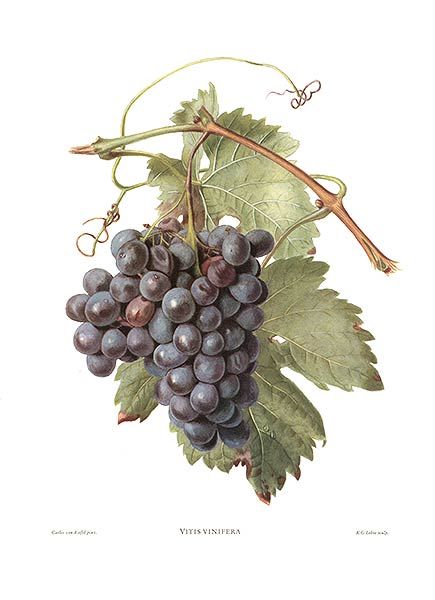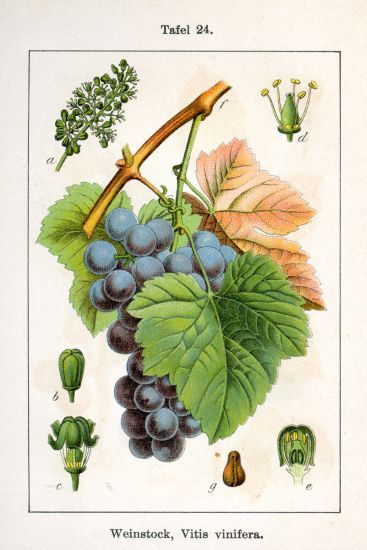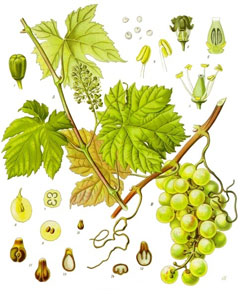The vine is a climbing and in nature it tends to grow on occasional supports or to crawl on the ground.
The stem has a dark bark that tends to flake longitudinally; it can be unique or divided into branches from which several shoots are born. These have the task of developing buds, leaves, bunches and tendrils; the latter are the structures with which the plant binds to the guardians. The branches are composed of even 20cm long nodes and internodes. The root system can be very deep and extended.
The vine leaf has a 3-6 cm long petiole and its lamina has lobes (from 3 to 5). The upper page is bright green while the lower page is lighter and pubescent; the leaf margin is toothed.
The flower of the vine is hermaphrodite and the pollination is mainly anemophilous. The flowers are gathered in a raceme inflorescence (also called a stalk). The fruit of the vine is the berry, a berry from the botanical point of view. Its seeds are called pips. The berries make up the bunch; this can have different shapes (cylindrical, pyramidal) and be compact or very open.
The vegetative cycle of the vine begins at the end of winter with budding. This is preceded by the phenomenon of 'weeping', due to the leakage of liquid from the pruning cuts; this happens due to the increased absorption of liquids by the root system. Sprouting occurs when the average temperature is kept at 10 ºC for 7-10 days; its beginning depends on the latitude and altitude, the type of vine and the cultivation techniques. The growth of the bud lasts until the middle of June after which it decreases constantly until stopping at the beginning of August. At this point we have the agostamento which consists in the lignification of the shoots.The flowering takes place between mid-May to June, depending on the variety and the location of the vines. After fertilization there is the growth and maturation of the berries that can last up to 120 days. The development of the berries passes through three phases: herbaceous, translucent and ripening. In the first phase they have a diameter of a few millimeters, a green color (they are photosynthesized organs) and show a rapid accretion. In the second phase the growth stops and there is the so-called ripening with which the peel takes on its final color. With the maturation, inside the berry there is the enlargement of the cells, the increase of sugars, the decrease of acids and the synthesis of aromatic substances.
Before the glaciations of the Pleistocene the vine had to be spread from Europe to Asia and then it took refuge in the Mediterranean basin and in some Asian territories. It seems that the wild form was tamed 5 thousand years ago by the Caucasian peoples. From the Caucasus the domestic vine then spread to the fertile crescent. The first testimonies on the cultivation of the vine and the consumption of wine are a Sumerian writing and the remains of a cellar both of the third millennium BC. The Phoenicians spread the culture of wine in the Mediterranean basin and the Greeks were the first to conceive a specialized viticulture. They also introduced it to Sicily with the birth of their colonies. In the center and in the north of Italy the spreading of the vine was promoted by the Etruscans who possessed evolved notions of wine and agriculture. Later the Romans exported the cultivation of this plant within the borders of their empire, from Spain to the Danube. In the II century a. C. the vine is one of the main crops and the vineyards become real plantations. The Romans introduced some cultivation techniques that lasted in Campania until 1700 and selected various varieties that have survived, without major changes, until today. The iconographies of all ancient peoples often illustrate the harvesting, vinification and consumption of wine. Much of the bronze pottery and tableware was intended for the consumption of wine at banquets. This was often diluted with water and embellished with spices and various aromas. Wine was attributed a religious character; it was in fact consumed in symposia dedicated to Dionysius (in the case of the Greeks) or Bacchus (in the case of the Romans).
The sacredness of the vine and wine does not disappear with the advent of the Christian faith; Wine represents the blood of Christ shed for the redemption of man. In a famous parable Jesus compares himself to a vine where the branches (representing the disciples) can live only attached to the plant and not detached from it. With the crisis of the Roman Empire viticulture went into decline and the few vineyards survived near the settlements and inside the monasteries. «Ecclesiastical» viticulture was fundamental for the preservation of knowledge about the cultivation and production of wine (this was used during the celebration of the Mass). Only between the XI and the XIII century, in the communal age, did people return to invest in agriculture and viticulture.The most common natural enemies of vines are phylloxera, powdery mildew and downy mildew. Phylloxera is a mite native to North America that causes serious damage to the roots. Downy mildew is a microorganism belonging to oomycetes (also native to America) that attacks the leaves and bunches of grapes. Powdery mildew is an ascomycota fungus, whose spores attack the stalk of the cluster causing its death.The North American parasites arrived in Europe in the mid 1800’s and had a strong impact on viticulture. It was possible to save the vineyards from phylloxera by grafting the European vines with rooted American vines; these are in fact resistant to the parasite. In the plants you can notice the point of grafting that looks like an enlargement of the stem just above the ground level.To eradicate powdery mildew and downy mildew treatments were introduced with sulfur and copper (Bordeaux pulp). Currently in Italy are cultivated about 350 types of vines. In the territory of Capolona we find: Sangiovese, Mammolo, Syrah, Merlot, Canaiolo, Cabernet Sauvignon and Ancillotta. The main producers manage the vines according to the organic method and try to guarantee the local biodiversity by maintaining the alternation between vineyards, woods, hedges and other elements of the traditional rural landscape.


